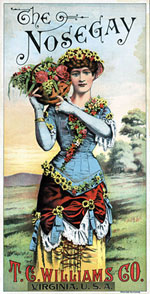Human Flower Project
Saturday, July 25, 2009
Soothing Linalool
When 16th Century Aztec poets and 21st Century Japanese scientists agree, we’re really onto something.

Xochiquetzal (Aztec Flower Goddess)
Image: from the Codex Borgia, via Mexicolore
Did anyone notice that Meso-American folk culture and Japanese chemistry reached accord this week?
It happened in a whiff of marigold. Akio Nakamura and fellow researchers who’ve been stressing out lab rats found that that linalool “reduced the activity of more than 100 genes that go into overdrive in stressful situations.” The tormented rats that inhaled linalool—a fragrant oil in lavender, sweet pea, marigold and many other plants—showed blood levels far lower in stressor chemicals. The research suggests that this fragrance both protects the immune system and produces a soothing effect.
 “The Nosegay”
“The Nosegay”
Image: Library of Virginia
So fas as we know, the 16th Century Aztecs didn’t need to restrain rats to figure this out. Flowers were part of nearly all dimensions of sacred and secular life—from a complex cycle of flower poetry, to dances and games at harvest time, even military maneuvers. Aztec princes and warriors used nosegays to calm their nerves—and so did more everyday people:
In his Historia de las Indias de Nueva España (1581), Fray Diego Durán wrote of the Aztec people: “They find gladness and joy in spending the entire day smelling a little flower or bouquet made of different kinds of flowers; their gifts are accompanied by them; they relieve the tediousness of journeys with flowers.”
(If only Henry Louis Gates had stopped by a flower shop on his way back from China, and the Cambridge P.D. issued bouquets along with handcuffs.)




